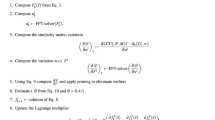Abstract
The Variational Principle (VP) forms diffeomorphisms (non-folding grids) with prescribed Jacobian determinant (JD) and curl under an optimal control set-up, which satisfies the properties of a Lie group. To take advantage of that, it is meaningful to regularize the resulting deformations of the image registration problem into the solution pool of VP. In this research note, (1) we provide an optimal control formulation of the image registration problem under a similar optimal control set-up as is VP; (2) numerical examples demonstrate the confirmation of diffeomorphic solutions as expected.
Access provided by Autonomous University of Puebla. Download conference paper PDF
Similar content being viewed by others
Keywords
- Diffeomorphic image registration
- Computational diffeomorphism
- Jacobian determinant
- Curl
- Green’s identities
1 Our Approach to Image Registration
This work connects the resulting registration deformations to the solution pool of VP in [1], which achieves a recent progression in describing non-folding grids in a diffeomorphism group. Hence, to restrict the image registration method built in [3] satisfying the constraint of VP, it is reformulated and proposed as follows: let \(I_{\pmb {m}}\) be a \(\pmb {moving}\) image is to be registered to a \(\pmb {fixed}\) image \(I_{\pmb {f}}\) on the fixed and bounded domain \((\pmb {\omega }=<x,y,z>\in )\mathrm {\Omega } \subset \mathbb {R}^{3}\), the energy function Loss is minimized over the form \(\pmb {\phi }=\pmb {id}+\pmb {u}\) on \(\mathrm {\Omega }\) with \(\pmb {u} = \pmb {0}\) on \(\partial \mathrm {\Omega }\),
where the scalar-valued f and the vector-valued \(\pmb {g}\) are the control functions in the sense of VP that mimic the prescribed JD and curl, respectively.
1.1 Gradient with Respect to Control \(\pmb {F}\)
The variational gradient of (1) with respect to \(\delta \mathrm {\Delta } \pmb {\phi }=\delta \mathrm {\Delta }\pmb {u}=\delta \pmb {F}\) is derived. For all \(\delta \pmb {F}\) vanishing on \(\partial \mathrm {\Omega }\) and by Green’s identities with fixed boundary condition,
where \(\mathrm {\Delta }\pmb {b} = (I_{\pmb {m}}(\pmb {\phi }) - I_{\pmb {f}}) \nabla I_{\pmb {m}}(\pmb {\phi })\), so, a gradient-based algorithm can be formed.
1.2 Hessian Matrix with Respect to Control Function \(\pmb {F}\)
In case of a Newton optimizing scheme is applicable, from (2), one can derive the Hessian matrix \(\pmb {H}\) of (1) with respect to \(\pmb {F}\) as follows,
A necessary condition that ensures a Newton scheme works is to show such Hessian \(\pmb {H}\) must be of Semi-Positive Definite matrix. This is left for future study.
1.3 Partial Gradients with Respect to Control Functions \(\hat{f}\) and \(\pmb {g}\)
To ensure (1) producing diffeomorphic solutions that is controlled by \(J_{min}\in (0,1)\), instead of optimizing along \(\pmb {F}\) by (2), it can be set that \(f:= J_{min}+\hat{f}^{2}\) in (1). Since it is known \( \delta \mathrm {\Delta } \pmb {u} = \delta \pmb {F} = \delta (\nabla f-\nabla \times \pmb {g})\), then, it carries to,
2 Numerical Examples
In our algorithms, \(J_{min}=0.5\) is artificially set. It is desirable to design a mechanism that yields optimal values of \(J_{min}\). The gradient-based algorithms can be structured with (1) the coarse-to-fine multiresolution technique, which fits better in large deformation problems over binary images, as it did in [2]; and (2) the function composition regriding technique, which divides the problem difficulty and prevent non-diffeomorphic solutions on medical image registrations. These observations are demonstrated by the next example.
2.1 A Large Deformation Test and a MRI Registration Test
The J-to-V part of this example is done with multiresolution and the Brain Morph part is done with regriding. In Fig. 1(c, j), \(\pmb {\phi }\) is the diffeomorphic solution found by the proposed method; Fig. 1(d, k), \(I_{\pmb {m}}(\pmb {\phi })\) is the registered image that is close to \(I_{\pmb {f}}\), Fig. 1(b, i). Next, \(\pmb {\phi }_{vp}^{-1}\) is the inverse of \(\pmb {\phi }\) that constructed by VP. In Fig. 1(f,m), \(\pmb {\phi }\) is composed by \(\pmb {\phi }^{-1}\), in Red grid, and superposed on Black grid \(\pmb {id}\) but the Black grid barely shows. This shows the composition \(\pmb {T}=\pmb {\phi }_{vp}^{-1}\circ \pmb {\phi }\) is very close to \(\pmb {id}\). Therefore, \(\pmb {\phi }_{vp}^{-1}\) can be treated as the inverse to \(\pmb {\phi }\) and they are of the same diffeomorphism group which VP focuses (Fig. 1).
The question is whether \(\pmb {\phi }_{vp}^{-1}\) is also a valid inverse registration deformation that moves \(I_{\pmb {f}}\) back to \(I_{\pmb {m}}\). The answer is YES, at least in our tested examples. \(I_{\pmb {f}}(\pmb {\phi }_{vp}^{-1})\) is indeed close to \(I_{\pmb {m}}\). That means \(\pmb {\phi }_{vp}^{-1}\) can be treated as a valid registration deformation from \(I_{\pmb {f}}\) to \(I_{\pmb {m}}\), as it is confirmed by the Table 2 records.
3 Discussion
This note provides the analytic description with simple demonstration of the proposed method. A full paper with extensive experiments will be available soon.
References
Zhou, Z., Liao, G.: Construction of diffeomorphisms with prescribed jacobian determinant and curl. In: International Conference on Geometry and Graphics, Proceedings (2022). (in press)
Zhou, Z., Liao, G.: A novel approach to form Normal Distribution of Medical Image Segmentation based on multiple doctors\(^{\prime }\) annotations. In: Proceedings of SPIE 12032, Medical Imaging 2022: Image Processing, p. 1203237 (2022). https://doi.org/10.1117/12.2611973
Zhou, Z.: Image Analysis Based on Differential Operators with Applications to Brain MRIs, Ph.D. Dissertation, University of Texas at Arlington (2019)
Author information
Authors and Affiliations
Corresponding author
Editor information
Editors and Affiliations
Rights and permissions
Copyright information
© 2022 The Author(s), under exclusive license to Springer Nature Switzerland AG
About this paper
Cite this paper
Zhou, Z., Liao, G. (2022). Recent Developments of an Optimal Control Approach to Nonrigid Image Registration. In: Hering, A., Schnabel, J., Zhang, M., Ferrante, E., Heinrich, M., Rueckert, D. (eds) Biomedical Image Registration. WBIR 2022. Lecture Notes in Computer Science, vol 13386. Springer, Cham. https://doi.org/10.1007/978-3-031-11203-4_22
Download citation
DOI: https://doi.org/10.1007/978-3-031-11203-4_22
Published:
Publisher Name: Springer, Cham
Print ISBN: 978-3-031-11202-7
Online ISBN: 978-3-031-11203-4
eBook Packages: Computer ScienceComputer Science (R0)





